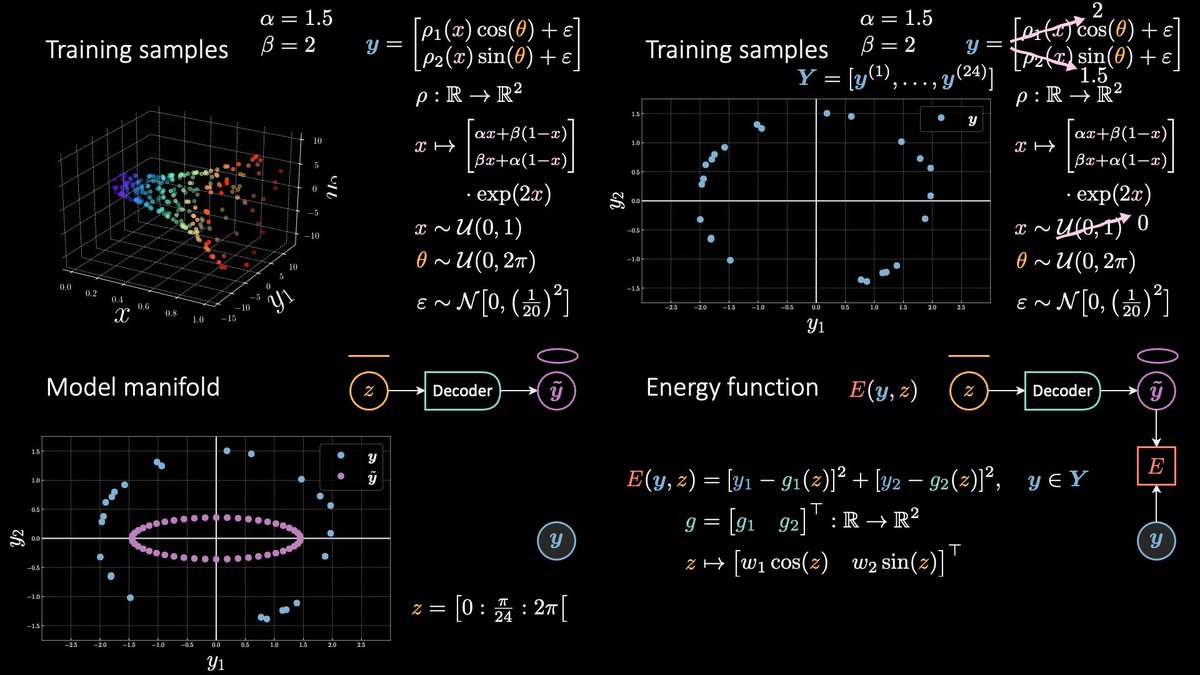
This week we went through the second part of my lecture on latent variable 👻 energy 🔋 based models. 🤓
We've warmed up a little the temperature 🌡, moving from the freezing 🥶 zero-temperature free energy Fₒₒ(y) (you see below spinning) to a warmer 🥰 Fᵦ(y).



We've warmed up a little the temperature 🌡, moving from the freezing 🥶 zero-temperature free energy Fₒₒ(y) (you see below spinning) to a warmer 🥰 Fᵦ(y).
https://twitter.com/alfcnz/status/1319121960429887488




Be careful with that thermostat! If it's gonna get too hot 🥵 you'll end up killing ☠️ your latents 👻 and end up with averaging them all out, indiscriminately, ending up with plain boring MSE (fig 1.3)! 🤒
From fig 2.1–3, you can see how more z's contribute to Fᵦ(y).
From fig 2.1–3, you can see how more z's contribute to Fᵦ(y).
This is nice, 'cos during training (fig 3.3, bottom) *The Force* will be strong with a wider region of your manifold, and no longer with the single Jedi. This in turns will lead to a more even pull and will avoid overfitting (fig 3.3, top). Still, we're fine here because z ∈ ℝ.
Finally, switching to the conditional / self-supervised case, where we introduce an observed x, requires changing 1 line of code! 🤯
Basically, self-sup and un-sup are super close in programming space! 😬
So, learning the horn 📯 was easy peasy! 😎
Made with @matplotlib as usual.
Basically, self-sup and un-sup are super close in programming space! 😬
So, learning the horn 📯 was easy peasy! 😎
Made with @matplotlib as usual.
For reference, the (now correct) training data is shown below. Pay attention that ∞ y's (an entire ellipse) are associated to a give x. So, you cannot hope to use a neural net to train on (x, y) pairs. That model would collapse into the segment (0, 0, 0) → (1, 0, 0).
One more note. 🧐
Fig 1.4 shows the *correct* terminology 👍🏻 vs. what is currently commonly used 👎🏻.
Actual softmax → "logsumexp" (scalar).
Its derivative, softargmax → "softmax" (pseudo probability).
This is analogous to max and, its derivative, argmax. But softer. 😀
Fig 1.4 shows the *correct* terminology 👍🏻 vs. what is currently commonly used 👎🏻.
Actual softmax → "logsumexp" (scalar).
Its derivative, softargmax → "softmax" (pseudo probability).
This is analogous to max and, its derivative, argmax. But softer. 😀

• • •
Missing some Tweet in this thread? You can try to
force a refresh










